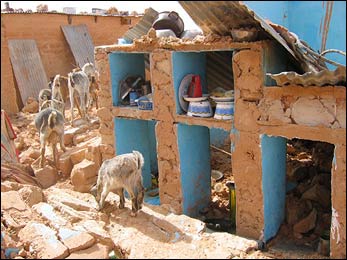- Text size
 |
|  |
|  |
| 
- Français
Rare torrential rains leave 50,000 Sahrawi refugees in Algeria homeless
News Stories, 13 February 2006

TINDOUF, Algeria, Feb 13 (UNHCR) – Rare torrential rains over the last few days in the deserts around Tindouf have caused severe flooding in three of five Sahrawi refugee camps, destroying nearly 50 percent of shelters and leaving, according to initial estimates, some 50,000 refugees homeless. An emergency aid operation is being mounted to bring urgent relief to the homeless.
"We are very concerned about the effect the flood damage will have on the Sahrawi refugees who have already lived under very difficult circumstances for so long," said Radhouane Nouicer, UNHCR's Geneva-based deputy director for the region. "We will join hands with all concerned agencies to address this situation without delay."
On Saturday, a joint rapid assessment mission by the UN refugee agency, the World Food Programme and local aid agencies visited two of the three affected camps in the Tindouf region. In Awserd and Smara where the overwhelming majority of refugees live in mud-brick houses and some 25 percent live in tents, the structural damage was found to be enormous with 50 percent of the houses completely destroyed, and the remainder of houses damaged and in a precarious condition. Market areas and public buildings, including schools and refugee administration buildings, were also damaged.

Laayoune camp is also expected to be badly damaged, and UNHCR is still awaiting further details on camp conditions. The camp could not be reached by the joint mission on Saturday but a local aid agency managed to reach the camp on Friday, before the last heavy downpour that night. Even at that stage, they reported 25-30 percent of the mud-brick houses were completely destroyed, with at least 70 percent of families' food stocks ruined.
The emergency assessment mission estimates 12,000 tents are needed, along with plastic sheeting for 12,000 families, 510 plastic rolls, 7,000 kitchen sets, 60,000 blankets, 40,000 mattresses, and 20,000 jerry cans. An airlift of supplies from a UNHCR regional warehouse in Jordan is being planned.
The refugee camps in the Tindouf area host refugees who fled Western Sahara in 1975 during the conflict over the right to govern the Territory after Spain withdrew from the region. UNHCR is presently supporting 90,000 of the most vulnerable refugees in five camps.
































